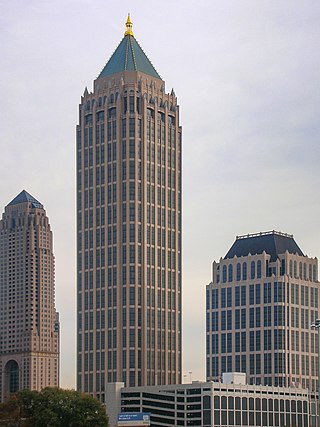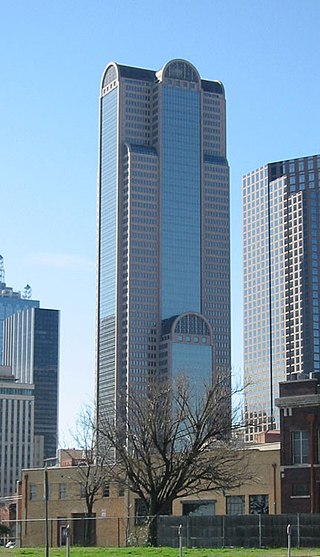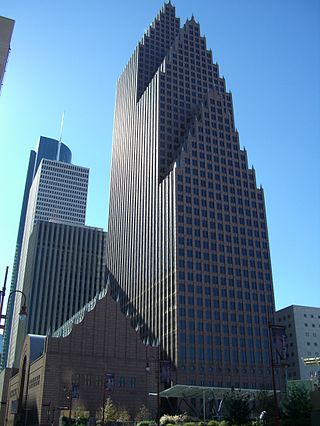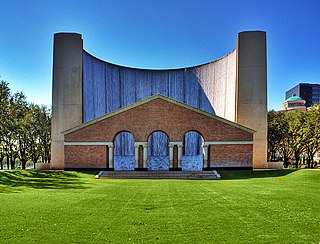
John Burgee is an American architect noted for his contributions to Postmodern architecture. He was a partner of Philip Johnson from 1967 to 1991, creating together the partnership firm Johnson/Burgee Architects. Their landmark collaborations included Pennzoil Place in Houston and the AT&T World Headquarters in New York. Burgee eased Johnson out of the firm in 1991, and when it subsequently went bankrupt, Burgee's design career was essentially over. Burgee is retired, and resides in California.

Philip Cortelyou Johnson was an American architect who designed modern and postmodern architecture. Among his best-known designs are his modernist Glass House in New Canaan, Connecticut; the postmodern 550 Madison Avenue in New York City, designed for AT&T; 190 South La Salle Street in Chicago; the Sculpture Garden of New York City's Museum of Modern Art; and the Pre-Columbian Pavilion at Dumbarton Oaks. His January 2005 obituary in The New York Times described his works as being "widely considered among the architectural masterpieces of the 20th century".

The JPMorgan Chase Tower, formerly Texas Commerce Tower, is a 305.4-meter (1,002-foot), 2,243,013-square-foot (208,382.7 m2), 75-story skyscraper at 600 Travis Street in Downtown Houston, Texas, United States. It is currently the tallest building in Texas and the South Central region of the United States, the tallest five-sided building in the world, the 29th-tallest building in the United States, and the 107th-tallest building in the world.

One Atlantic Center, also known as IBM Tower, is a skyscraper located in Midtown Atlanta, Georgia. It is the third tallest building in Atlanta.

One Ninety One Peachtree Tower is a 235 m (771 ft) 50-story skyscraper in Atlanta, Georgia. Designed by Johnson/Burgee Architects and Kendall/Heaton Associates Inc, the building was completed in 1990 and is the fourth tallest in the city, winning the BOMA Building of the Year Awards the next year, repeating in 1998 and 2003.

Comerica Bank Tower is a 60-story postmodern skyscraper located at 1717 Main Street in the Main Street District in downtown Dallas, Texas. Standing at a structural height of 787 feet (240 m), it is the third tallest skyscraper in the city of Dallas. It is also the sixth tallest building in Texas and the 61st tallest building in the United States. The building was designed by Philip Johnson and John Burgee, and was completed in 1987. The structure has 1,500,000 square feet (100,000 m2) of office space.

The Williams Tower is a 64-story, 1.4 million square feet (130,000 m2) class A postmodern office tower located in the Uptown District of Houston, Texas. The building was designed by New York–based John Burgee Architects with Philip Johnson in association with Houston-based Morris-Aubry Architects. Construction began in August 1981, and the building was opened in 1983. The tower is among Houston's most visible buildings as the 4th-tallest in Texas, and the 44th-tallest in the United States. The Williams Tower is the tallest building in Houston outside of Downtown Houston, and is the tallest skyscraper in the United States outside of a city's central business district. It has been referred to as the "Empire State Building of the south".

The TC Energy Center is a highrise that represents one of the first significant examples of postmodern architecture construction in downtown Houston, Texas. The building has been formerly known as the RepublicBank Center, the NCNB Center, the NationsBank Center, and the Bank of America Center. The building was completed in October 1983 and designed by award-winning architect Johnson/Burgee Architects, and is reminiscent of the Dutch Gothic architecture of canal houses in The Netherlands. It has three segmented tower setbacks, each with "a steeply pitched gabled roofline that is topped off with spires". The tower was developed by Hines Interests and is owned by a joint venture of M-M Properties and an affiliate of the General Electric Pension Trust.

The Renaissance Center, commonly known as the RenCen, is a complex of seven connected skyscrapers in downtown Detroit, Michigan, United States. The Renaissance Center complex is on the Detroit International Riverfront and is owned and used by General Motors as its world headquarters. The central tower has been the tallest building in Michigan since its completion in 1977.

PPG Place is a complex in downtown Pittsburgh, Pennsylvania, consisting of six buildings within three city blocks and five and a half acres. PPG Place was designed by architects Philip Johnson and John Burgee.

Ally Detroit Center, formerly One Detroit Center, is a skyscraper and class-A office building located in Downtown Detroit, overlooking the Detroit Financial District. Rising 619 feet (189 m), the 43-story tower is the tallest office building in Michigan and the second tallest building overall in the state behind the central hotel tower of the Renaissance Center, located a few blocks away. Although the Penobscot Building has more floors above ground (45), those of Ally Detroit Center are taller, with its roof sitting roughly 60 feet (18 m) taller than that of the Penobscot. It has a floor area of 1,674,708 sq ft (155,585.5 m2).

The Gerald D. Hines Waterwall Park, formerly the Williams Waterwall and the Transco Waterwall, is a multi-story sculptural fountain that sits opposite the south face of Williams Tower in the Uptown District of Houston. The fountain and its surrounding park were built as an architectural amenity to the adjacent tower. Both the fountain and tower were designed by John Burgee Architects with Philip Johnson. Originally privately owned in common with the office tower, the waterwall and the surrounding land were purchased by the Uptown Houston Tax Increment Reinvestment Zone, a non-profit local government corporation, in 2008 to ensure the long-term preservation of the waterwall and park. The fountain currently operates between 10 am and 9 pm.

1180 Peachtree, commonly known as the Symphony Tower, is a 41-story skyscraper located at 1180 Peachtree Street in the Midtown district of Atlanta, Georgia, United States. Rising to a height of approximately 657 feet (200 m), the building includes office and retail space in its 624,996 sq ft (58,064 m2) of floor area as well as a 1,200 space parking deck. Construction was completed in 2006.

The architecture of Houston includes a wide variety of award-winning and historic examples located in various areas of the city of Houston, Texas. From early in its history to current times, the city inspired innovative and challenging building design and construction, as it quickly grew into an internationally recognized commercial and industrial hub of Texas and the United States.

Gerald Douglas Hines was an American real estate developer based in Houston. He was the founder and chairman of Hines, a privately held real estate firm with its headquarters in that city. At the time of his death, the company had assets in 25 countries.

One Shell Plaza (OSP) is a 50-story, 218 m (715 ft) skyscraper at 910 Louisiana Street in Downtown Houston, Texas. Perched atop the building is an antenna that brings the pinnacle height of the building to 304.8 m (1,000 ft). At its completion in 1971, the tower was the tallest in the city.

First City Tower, located at 1001 Fannin, is a skyscraper in downtown Houston, Texas. The building rises 662 feet (202 m) in height. Completed in 1981, it contains 49 floors. First City Tower currently stands as the 14th-tallest building in the city. The architectural firm who designed the building was Morris-Aubry, and was built by W. S. Bellows Construction Corporation. The structure is an example of late-modernist architecture. The tower, which formerly housed the headquarters of the now-defunct First City National Bank, now serves as the global headquarters of Waste Management, Inc, and the headquarters of Vinson & Elkins. It also houses the U.S. headquarters of Campus Living Villages.
The architecture of the U.S. state of Texas comes from a wide variety of sources. Many of the state's buildings reflect Texas' Spanish and Mexican roots; in addition, there is considerable influence from mostly the American South as well as the Southwest. Rapid economic growth since the mid twentieth century has led to a wide variety of contemporary architectural buildings.

609 Main at Texas is a skyscraper in Houston, Texas.























